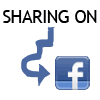1. People who have never tried it don’t get it.
As far as I can tell, the naysayers have never tried Twitter. I’ve seen people complain about Twitter on Facebook, but a Facebook status update and a tweet are nearly the same: short snippets of information that you want to share.
The at-signs (@) and hashes (#) that have become ubiquitous on Twitter may be part of the problem. Although I feel that if you can decipher an emoticon you ought to be able to handle @replies and #hashtags.
The difference?
A tweet is public if your Twitter timeline is public. (A timeline is akin to your wall on Facebook.) This is probably one reason why marketers love it: they get to push links out to the world, including search engines, whereas on Facebook you actually have to work to build an audience. (More on Facebook later.)
2. It’s addictive.
Clearly, it can be. Maybe not to the same extent as nicotine, but some people can’t stay off Twitter. People complain about how many breaks smokers take. Sick of your friends leaving you alone at a party while they compose a tweet? Annoyed that they ignore you to check the latest on their Blackberries? Tired of your co-workers taking tweet breaks? Which leads to…
3. It interrupts you.
Cravings for cigarettes driving you to distraction? Twitter can drive you insane. I quickly disabled updates on my phone, because I would have exceeded my 400 monthly SMS messages in the span of a few days. I installed twhirl, and later TweetDeck, and found that I was getting notifications almost every minute. That’s no way to work. I changed my TweetDeck settings to check for updates every 40 minutes. I may find out about the latest celebrity death 10 minutes after you do, but I still have some semblance of mental focus.
4. Users love to talk about it
Smokers love to talk about smoking. What brand you smoke, the way you hold your cigarettes, whether or not you prefer hard-packs or soft-packs, whether or not you pack your cigarettes before you open them–these are the sorts of conversations people have on their smoke breaks. My friend Brady cited all the unnecessary talking about smoking as a top reason to quit smoking.
Twitterers love to talk about Twitter. People are in love with Twitter right now, and they aren’t afraid to shout it from the rooftops. Which apps they use, who they follow, how it can turn their struggling companies into a giants. Even I am guilty of this: about a quarter of my tweets reference Twitter. I imagine this may fade over time, along with the accompanying backlash. After all, remember blowthedotoutyourass.com?
5. You do it more when you’re drinking.
…and that’s not a good thing.
6. Short and unsatisfying.
Oscar Wilde wrote, “A cigarette is the perfect type of a perfect pleasure. It is exquisite, and it leaves one unsatisfied.” I’ve seen people pack a lot of info into a mere 140 characters, but sometimes 140 characters just isn’t enough. That is why more than half of the tweets I am perusing right now contain shortened links from sites like bit.ly, short.to, ff.im, and tr.im.
[I actually really dislike shortened links, because they remove a critical piece of info–the destination URL–from the link. If someone posts a link with little-to-no explanation, I will not click on it for two reasons: one, there’s no incentive, two, it could be spam or lead to a malicious web site.]
7. It’s bad for your health.
OK, I admit it: that’s a weak link. Just don’t tweet while driving, OK? But just as smokers often pass on exercise, Twitter may cause people or companies to scrimp on more important things, like phone calls, face-to-face conversations, making good products, or even updating Facebook. Time spent on Twitter is time not spent on something else.
(That’s right, I said Facebook. As I mentioned to a friend recently, if Facebook stepped on Twitter, Facebook would hardly notice. Check out Facebook vs. Twitter on Compete.com. To which should you devote more time?)
Afterthoughts
I should note that I have been tobacco-free for years and would never advocate tobacco use. On the other hand, I think with some caveats, Twitter can be fun, useful, and relatively harmless.
I decided to capitalize Twitter in this post because it is a proper noun. I’ll respect bell hooks’ preference for lowercasing, but that’s where I decided to draw the line this time; I reserve the right to be inconsistent.
Additions?
Feel free to contribute your own comparisons in the comments!
 You’ve made a Facebook page and a Twitter account. You’ve even added “chicklets” to your site to let people easily share your content. But are your pages optimized for sharing?
You’ve made a Facebook page and a Twitter account. You’ve even added “chicklets” to your site to let people easily share your content. But are your pages optimized for sharing?